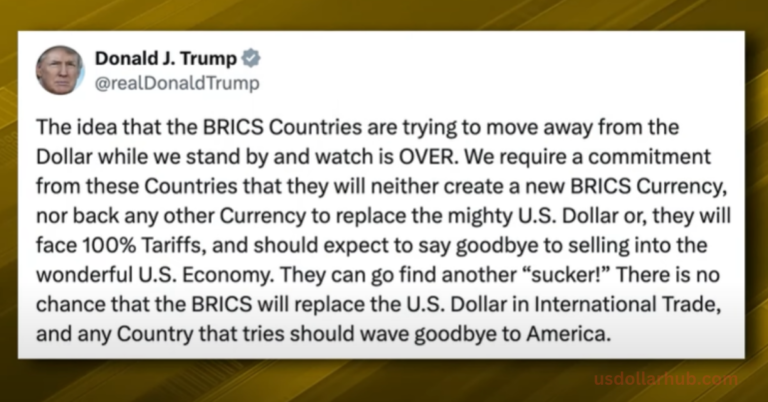US Dollar Under Threat: BRICS+ Pushes to Reduce Reliance – A Game-Changer for Global Finance 2024
BRICS+ Challenges the Dominance of the US Dollar

The BRICS+ group—now including Egypt, Ethiopia, Iran, and the UAE—has set its sights on reducing dependence on the US dollar. For decades, the US dollar has been the backbone of global finance, but rising geopolitical tensions and economic sanctions are forcing countries to seek alternatives. At the recent BRICS Summit, member nations laid out strategies to reshape the global financial landscape by moving away from dollar-centric trade and payments.
Why BRICS+ Wants to Break Free from the US Dollar
1. Geopolitical Sanctions and Financial Constraints
Countries like Russia and Iran have been hit hard by Western sanctions, often tied to the US dollar-dominated financial system. Russia’s removal from the SWIFT network after the Ukraine conflict is a prime example. To regain financial independence, BRICS+ nations are turning to non-dollar alternatives for cross-border trade.
2. Reducing Economic Vulnerabilities Tied to the US Dollar
Overreliance on the US dollar makes economies vulnerable to exchange rate volatility and political risks. By reducing dollar use, BRICS+ nations aim to protect themselves from potential financial disruptions and improve the stability of their economies.
How BRICS+ Is Reshaping Global Trade Without the US Dollar
Trade in National Currencies as an Alternative to the US Dollar
BRICS+ countries are increasingly conducting bilateral trade using national currencies. Russia’s trade with China, for instance, now sees 97% of transactions settled in yuan or rubles. India, too, is promoting rupee-based trade with countries like the UAE, reducing the need for the US dollar.
This shift reflects a broader strategy: If more trade happens in local currencies, BRICS+ nations can cut their reliance on the dollar and build financial resilience.
Fuel Trade Moving Away from the US Dollar
The energy sector is another key area where de-dollarization is gaining ground. BRICS+ controls 37% of the global fuel trade, and the group is now focused on pricing energy deals in national currencies. This could diminish the role of the dollar in global oil and gas markets.
BRICS+ Adds Gold to Reduce Dependence on the US Dollar

Gold is emerging as a safe haven asset for BRICS+ countries looking to diversify away from the US dollar. Although gold currently accounts for only 10% of BRICS+ central bank reserves, there’s a steady push to increase gold holdings. This strategy reflects the bloc’s desire to reduce exposure to dollar-backed assets and create a more balanced reserve portfolio.
New Payment Systems Aimed at Bypassing the US Dollar
BRICS Pay and BRICS Bridge: Building Non-Dollar Payment Networks
To avoid using the US dollar-dominated SWIFT system, BRICS+ has been developing alternative payment solutions. BRICS Pay and BRICS Bridge are designed to facilitate cross-border transactions without relying on Western financial networks. These systems allow member nations to trade directly in their own currencies, bypassing the dollar.
Exploring Digital Currencies to Sidestep the US Dollar
Several BRICS+ countries are experimenting with central bank digital currencies (CBDCs). Projects like mBridge aim to streamline cross-border payments using digital currencies. While the technology is still in its early stages, CBDCs could eventually reduce the need for the US dollar in international transactions.
Challenges BRICS+ Faces in Dethroning the US Dollar
Despite these efforts, the US dollar remains deeply entrenched in global financial markets. The dollar is still the preferred currency for international debt, reserves, and payments through platforms like SWIFT. Additionally, trust and coordination among BRICS+ nations will be critical for these initiatives to succeed.
Experts caution that reducing reliance on the dollar will take time, but the long-term potential of BRICS+ currencies should not be underestimated.
Impact of BRICS+ Efforts on the Future of the US Dollar
BRICS+ is laying the foundation for a new financial system that is less dependent on the US dollar. As more trade is conducted in national currencies and non-dollar payment networks gain traction, the global dominance of the dollar could gradually erode.
While the dollar still holds sway today, the rise of BRICS+ shows that countries are serious about finding alternatives. If successful, this shift could redefine global finance and create a more multipolar world order.
What’s Next for the US Dollar?
- BRICS+ nations are actively working to reduce their reliance on the US dollar through trade in national currencies and new payment networks.
- Gold reserves are being built up as a way to diversify away from dollar-backed assets.
- BRICS Pay and CBDC projects aim to bypass Western financial systems and promote non-dollar payments.
- The US dollar remains dominant, but the momentum for de-dollarization is growing and could reshape the global economy over time.
Conclusion: Is the US Dollar’s Dominance at Risk?
The steps taken by BRICS+ show that the de-dollarization movement is not just symbolic—it’s real and gaining momentum. By promoting trade in national currencies, increasing gold reserves, and building alternative payment networks, BRICS+ is working to create a financial system independent of the US dollar.
While the US dollar won’t disappear anytime soon, its dominance is being questioned for the first time in decades. As geopolitical shifts accelerate, the financial world may soon find itself operating under a more diverse and multipolar currency system.
Also Visit for More – usdollarhub.com





One Comment